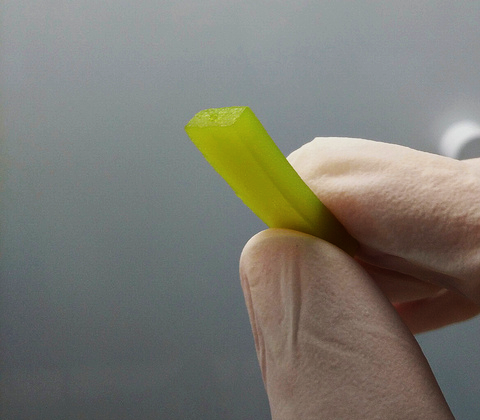New device to power wearable technologies
Research news
IFM researchers have proven it's possible to make a flexible thermocell for harvesting waste heat using a solid state electrolyte, opening up new applications for wearable technologies.
Wearable technologies, like those used to monitor movement during training or physiotherapy or even to power high-tech fashion accessories, are a step closer to reality following demonstration of a flexible thermocell made from a solid state, cellulose-based electrolyte.
Thermocells generate energy from waste heat using two electrodes in contact with an electrolyte.
The advantage of the thermocell is that the device never needs to be recharged – energy conversion is instant and continuous as long as one electrode is heated and the other is kept cold. These devices are being developed within the ARC Centre of Excellence for Electromaterials Science (ACES).
ACES Chief Investigator A/Prof Jenny Pringle, who led the work, said that until recently ACES has primarily pursued thermocells made from liquid electrolytes.
"Up until now, our work has focused on developing a thermocell using liquid electrolytes, such as ionic liquids. This is still an important area of ACES research, as this type of cell has the capacity to generate clean energy from large sources of waste heat, like geothermal energy," Jenny said.
"These cells, using ionic liquids, can take advantage of higher temperatures of waste heat as the electrolyte doesn’t evaporate."
Jenny explained that a solid state electrolyte has a number of advantages over its liquid state rivals when it comes to powering small wearable devices.
"In order to generate energy from a waste heat source, like the body, we need a thermocell sensitive enough to respond to lower temperatures. It’s also got to be flexible so it can contour to the body, and yet still be strong enough to make a device," she said.
"Making a thermocell using a solid state electrolyte allows us to achieve these three aims while giving us the extra advantage of being able to promise no leaks, which is of course important in a device that will need to fit and move with the body," she said. "Using a naturally-occurring polymer such as cellulose is also an important first step towards biocompatibility."
The cellulose-based electrolytes, used for making solid state, flexible thermocells by IFM researcher Dr Liyu Jin, are reported in research published this month in ACS Energy Letters. While this work demonstrate the promise of a single cellulose-based cell, the next step towards application is to combine multiple cells together into arrays to increase the power.
"One of the advantages of being part of ACES is that because of the diversity of our network we will be able to follow this research through—we will work with our 3D printing experts to print the cells we create into an array, before integrating them into devices," Jenny said.
This is just one example of the types of projects on offer as part of a ACES Masters degree in Electromaterials.
Share this story

Key Fact
Thermocells generate energy from waste heat using two electrodes in contact with an electrolyte.
